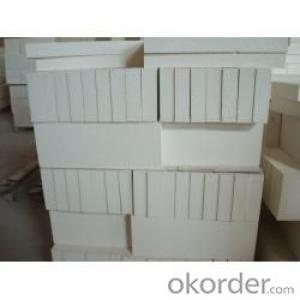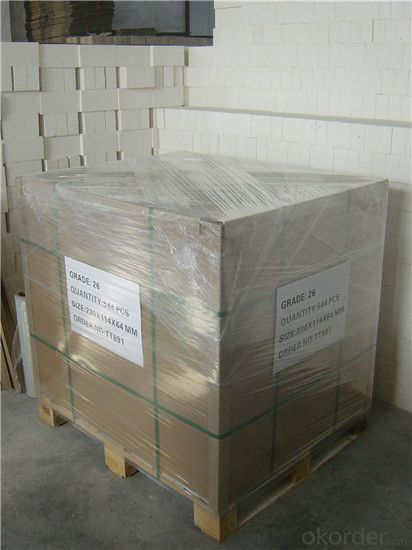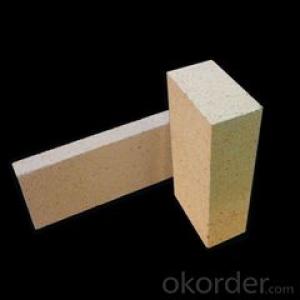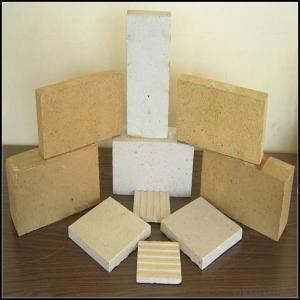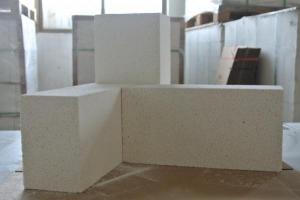Ultra High Temperature Insulating Fire Brick - Alumina Bubble Brick
- Loading Port:
- Tianjin
- Payment Terms:
- TT or LC
- Min Order Qty:
- 3 m.t.
- Supply Capability:
- 1000 m.t./month
OKorder Service Pledge
OKorder Financial Service
You Might Also Like
Thermal Insulation Fire Clay Brick
CNBM conforms strictly to the requirements of ISO 9000 quality control system during the production. MSDS is also available if you want. The thermal insulation fire clay brick meet with the requirements of ASTM & JIS standards. So please stay cool with our quality.
Application
Insulating Fire Brick are used for the lining of converter, alternating current arc furnace, direct Current arc furnace and the ladle slag line, etc.
Company Advantage
(1)Long Insulating Fire Brick manufacture history: 25 years manufacturer
(2)Advanced equipment
(3)Diversification of production standards: ISO ANSI FEPA JIS ASTM
(4)Flexible payment: T/T L/C D/P D/A
(5)Professional marketing team and after-sale service
(6)Free sample
Insulating Fire Brick main feature:


Equipment
1 unit of Ceramic Abrasive (SG Abrasive) pilot production line
2 units of Compact grain Abrasive pilot production lines
1 unit of high-end coated abrasives (abrasive cloth) production line
2 units of Boron Carbide production lines
3 large flexible crushing and sieving lines for grit production lines
2 units of 2000KVA furnaces for Boron Carbide fusion
6 units of 5000KVA-10000KVA dumping type electric arc furnaces for Brown Fused Alumina fusion
FAQs
Q1 What’s the transport method?
A1 FCL delivery goods with wooden pallet or wooden case by sea; If LCL delivery, must with wooden case; Sometimes need open top, flat rack or bulk cargo.
Q2 What’s the required payment term?
A2 Generally 30% TT as the prepayment, 70% TT before delivery. If need, 100% Irrevocable Letter of Credit or negotiation.
Q3 Which country are our products exported to?
A3 Apart from entire Chinese market, the US, Russia, Japan, Korea, Australia and some Southeast Asian Nations.
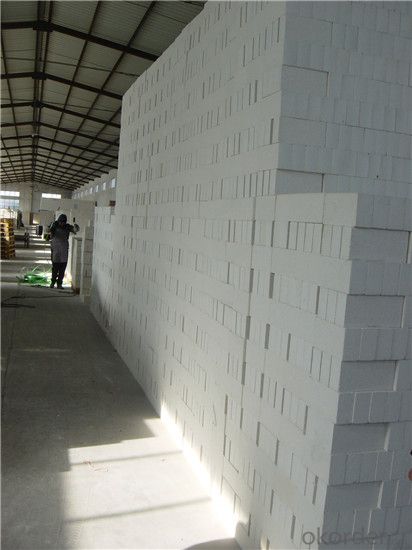

- Q: Are insulating fire bricks resistant to carbon monoxide attack?
- Yes, insulating fire bricks are generally resistant to carbon monoxide attack. Insulating fire bricks are made from materials that have a high resistance to high temperatures and chemical corrosion, including carbon monoxide. These bricks are often used in applications where high temperatures and exposure to various gases, including carbon monoxide, are common, such as in furnaces, kilns, and fireplaces. The composition of insulating fire bricks allows them to withstand prolonged exposure to carbon monoxide without deteriorating or reacting with the gas. However, it is important to note that prolonged exposure to extremely high levels of carbon monoxide can eventually cause damage to any material, including insulating fire bricks. Therefore, it is still necessary to ensure proper ventilation and safety measures when dealing with carbon monoxide in any setting.
- Q: What is the difference between cement foamed thermal insulation board and thermal insulating brick?
- The main difference between cement foamed thermal insulation board and insulating brick is that the shape is different, one is plate, and the other is brick. Both are new walls to achieve the effect of energy conservation and insulation.
- Q: Can insulating fire bricks be used in outdoor fire pits?
- Certainly, outdoor fire pits can make use of insulating fire bricks. These bricks are specifically engineered to endure high temperatures, rendering them suitable for fire pit applications. They are crafted from heat-resistant materials like ceramic fibers or refractory substances, which aid in preserving the heat within the fire pit. Moreover, insulating fire bricks possess a lightweight composition and are effortless to install, making them a practical selection for outdoor fire pits. Nevertheless, it is crucial to bear in mind that these bricks may not possess the same level of durability as regular fire bricks. Thus, they might necessitate more frequent replacement if exposed to extreme temperatures or harsh weather conditions.
- Q: Are insulating fire bricks resistant to thermal stress?
- Insulating fire bricks have the ability to resist thermal stress. These bricks are specifically designed to endure high temperatures and fluctuations without cracking or breaking. They are constructed from refractory materials that possess exceptional thermal insulation properties and can tolerate extreme heat. Insulating fire bricks possess a low thermal conductivity, allowing them to effectively resist heat transfer and maintain their structural integrity even when exposed to rapid temperature changes. They find common applications in kilns, furnaces, and fireplaces, where thermal stress is a major concern. In essence, insulating fire bricks are engineered to offer dependable and long-lasting insulation while enduring the thermal stress associated with high-temperature environments.
- Q: Are insulating fire bricks easy to handle and install?
- Insulating fire bricks are known for their ease of handling and installation. They possess a lightweight composition, enabling effortless transportation and portability. Furthermore, their user-friendly design, in terms of shape and size, facilitates simple manipulation and installation. The majority of insulating fire bricks are equipped with pre-drilled holes or grooves, further streamlining the installation process. Moreover, these bricks offer high versatility as they can be easily cut or shaped to accommodate specific dimensions or requirements. As a result, even individuals with limited expertise or familiarity in masonry work find insulating fire bricks to be manageable and straightforward to handle and install.
- Q: Can insulating fire bricks be used in chimneys and fireplaces?
- Yes, insulating fire bricks can be used in chimneys and fireplaces. Insulating fire bricks are specially designed to withstand high temperatures and provide excellent insulation. They are made from lightweight materials, such as ceramic fibers or refractory materials, which help to minimize heat transfer. This makes them an ideal choice for lining chimneys and fireplaces, as they can help to keep the heat inside the firebox and prevent it from escaping through the chimney. Additionally, insulating fire bricks can also help to improve the efficiency of the heating system by reducing heat loss and improving the overall heat output. However, it is important to note that insulating fire bricks should only be used in the appropriate areas of the chimney or fireplace, such as the firebox, and not in the smoke chamber or flue, as these areas require different types of bricks that can withstand the corrosive effects of the flue gases.
- Q: What is the cost of insulating fire bricks?
- The cost of insulating fire bricks can vary depending on various factors such as the quantity needed, the quality of the bricks, and the supplier. On average, insulating fire bricks can range from $2 to $5 per brick. However, the price can go higher for specialty bricks or those with specific features such as higher insulation ratings or increased durability. It is always recommended to obtain quotes from multiple suppliers to compare prices and ensure the best value for money.
- Q: Do insulating fire bricks absorb moisture?
- No, insulating fire bricks do not absorb moisture.
- Q: Can insulating fire bricks be used in the construction of boilers for steam generation?
- Indeed, insulating fire bricks possess the capability to be employed in the manufacturing process of steam-generating boilers. These bricks are purposefully engineered to possess a meager thermal conductivity, thereby mitigating heat dissipation and enhancing the boiler's overall energy efficiency. In practice, they are frequently utilized in the construction of boiler partitions, bases, and furnace linings, given their ability to endure extreme temperatures and bestow remarkable insulation attributes. The integration of insulating fire bricks in boiler construction ensures that the heat generated from fuel combustion is efficiently contained and transferred to the water, culminating in proficient steam generation.
- Q: Can insulating fire bricks be used in kilns?
- Indeed, kilns can utilize insulating fire bricks. These bricks are specifically engineered to endure extreme temperatures while offering exceptional insulation, rendering them highly suitable for kiln applications. Their low thermal conductivity plays a pivotal role in preserving the heat generated within the kiln, guaranteeing efficient and consistent heating. Furthermore, their lightweight nature facilitates effortless handling and installation in kilns. Moreover, they exhibit resistance to thermal shock, enabling them to withstand abrupt temperature fluctuations without succumbing to cracks or breakage. All in all, insulating fire bricks emerge as a dependable and efficient option for kiln usage.
Send your message to us
Ultra High Temperature Insulating Fire Brick - Alumina Bubble Brick
- Loading Port:
- Tianjin
- Payment Terms:
- TT or LC
- Min Order Qty:
- 3 m.t.
- Supply Capability:
- 1000 m.t./month
OKorder Service Pledge
OKorder Financial Service
Similar products
Hot products
Hot Searches
Related keywords
